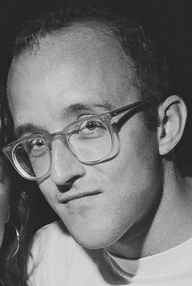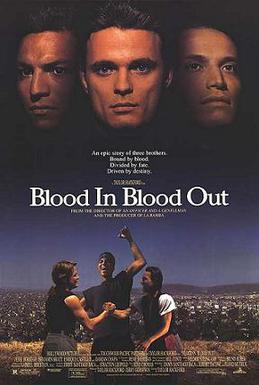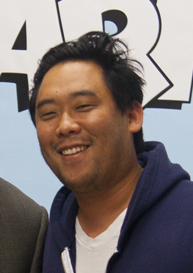
Graffiti is art that is written, painted or drawn on a wall or other surface, usually without permission and within public view. Graffiti ranges from simple written words to elaborate wall paintings, and has existed since ancient times, with examples dating back to ancient Egypt, ancient Greece, and the Roman Empire.

Keith Allen Haring was an American artist whose pop art emerged from the New York City graffiti subculture of the 1980s. His animated imagery has "become a widely recognized visual language". Much of his work includes sexual allusions that turned into social activism by using the images to advocate for safe sex and AIDS awareness. In addition to solo gallery exhibitions, he participated in renowned national and international group shows such as documenta in Kassel, the Whitney Biennial in New York, the São Paulo Biennial, and the Venice Biennale. The Whitney Museum held a retrospective of his art in 1997.
Mark Machado, better known as Mr. Cartoon or more commonly just Cartoon or Toon, is an American tattoo artist and graffiti artist based in Los Angeles, California. Growing up in the Harbor area of Los Angeles County, young Cartoon began doing illustrations and graffiti then going on to airbrushing clothing and lowrider custom cars. Machado then moved on to working in the music industry doing album covers, tour merchandise, and later tattooing recording artists and other celebrities.

Blood In Blood Out is a 1993 American epic crime drama film directed by Taylor Hackford that has become a cult-classic film among the Mexican-American community. It follows the intertwining lives of three Chicano relatives from 1972 to 1984. They start out as members of a street gang in East Los Angeles, and as dramatic incidents occur, their lives and friendships are forever changed. Blood In Blood Out was filmed in 1991 throughout Los Angeles and inside California's San Quentin State Prison.
George Lee Quiñones is a Puerto Rican artist and actor. Quiñones rose to prominence by creating massive New York City subway car graffiti that carried his moniker "LEE". His style is rooted in popular culture and often with political messages.

Homeboy Industries is a youth program founded in 1992 by Father Greg Boyle following the work of the Christian base communities at Dolores Mission Church in Boyle Heights, Los Angeles. The program is intended to assist high-risk youth, former gang members and the recently incarcerated with a variety of free programs, such as mental health counseling, legal services, tattoo removal, curriculum and education classes, work-readiness training, and employment services. A distinctive aspect of Homeboy Industries is its structure of a multifaceted social enterprise and social business. This helps young people who were former gang members and former inmates to have an opportunity to acquire job skills and seek employment in a safe, supportive environment. Among the businesses are the Homeboy Bakery, Homegirl Café & Catering, Homeboy/Girl Merchandise, Homeboy Farmers Markets, The Homeboy Diner at City Hall, Homeboy Silkscreen & Embroidery, Homeboy Grocery, and Homeboy Cafe & Bakery in the American Airlines terminal at Los Angeles International Airport.

David Choe is an American artist, musician, actor, and former journalist and podcast host from Los Angeles. Choe's work appears in a wide variety of urban culture and entertainment contexts. He has illustrated and written for magazines including Hustler, Ray Gun and Vice. He has an ongoing relationship with the Asian pop culture website, store, and former magazine Giant Robot.
Michael Christopher Tracy, known as Tracy 168, was an American graffiti artist. He pioneered the art form known as Wildstyle. Tracy 168 came to be known as one of the most influential graffiti and street artists of all time, as variations of Wild Style writing spread around the world. He is acknowledged to have been a seminal figure in the development of street art. Books about 1970s graffiti feature his car-long paintings with their characteristic kinetic script embellished with flames, arrows as well as cartoon characters and the "Tracy face," a grinning shaggy-haired visage in wrap-around shades.

Gregory Joseph Boyle, S.J. is an American Catholic priest of the Jesuit order. He is the founder and director of Homeboy Industries, the world's largest gang intervention and rehabilitation program, and former pastor of Dolores Mission Church in Los Angeles.

Lance Taylor, also known as Afrika Bambaataa, is an American DJ, rapper, and producer from the South Bronx, New York. He is notable for releasing a series of genre-defining electro tracks in the 1980s that influenced the development of hip hop culture. Afrika Bambaataa is one of the originators of breakbeat DJing.
RISK, also known as RISKY, is a Los Angeles–based graffiti writer and contemporary artist often credited as a founder of the West Coast graffiti scene. In the 1980s, he was one of the first graffiti writers in Southern California to paint freight trains, and he pioneered writing on "heavens", or freeway overpasses. He took his graffiti into the gallery with the launch of the Third Rail series of art shows, and later created a line of graffiti-inspired clothing. In 2017, RISK was knighted by the Medici Family.
Cristian Gheorghiu became famous as an American street artist/graffiti artist and contemporary painter under the name of Smear in the 2000s. He further rose to prominence in a series of high-profile arrests and subsequent articles on the arrests and on his art which appeared in the Los Angeles Times from 2009 to 2011, followed by television appearances and further media coverage. In 2011 the Los Angeles Times called Smear "a subculture sensation" and his work has appeared in contemporary art galleries, and a solo museum exhibit in 2009. He was also a defendant in a civil lawsuit filed by the L.A. City attorney's office, a lawsuit which largely because of its First Amendment implications has garnered the attention of international media, including the Huffington Post, L.A. Weekly, the Los Angeles Times, and the Associated Press.
In recent years, Atlanta has become one of the USA's best cities for street art. Street artists have prominently created murals in Krog Street Tunnel, along the BeltLine, and in neighborhoods across the city. The street art conference, Living Walls, the City Speaks, originated in Atlanta in 2009.

James Prigoff was an American photographer, author, and lecturer focusing on public murals, graffiti, and spraycan art. He has traveled extensively throughout the world documenting these art forms, and his personal archive of 100,000 slides may well be the most comprehensive of any individual mural and graffiti documentarian.
Levi Ponce is an American artist noted for his public portrait murals throughout urban areas of the San Fernando Valley and Southern California.

Angel Ortiz, known publicly as LA II or LA2, is an American graffiti artist and visual artist of Puerto Rican descent from the Lower East Side who is known for his collaborations with Keith Haring. Ortiz's contributions to Haring's work, including his trademark graffiti infill squiggles, have notably been obscured by the art establishment, which has prompted Ortiz's supporters, including artist, photographer, and videographer Clayton Patterson, to publicly uplift Ortiz's work and ask for credit to be given.
Joe "Peps" Galarza is a Chicano artist, educator, and musician based in Los Angeles. He is the bassist for the Chicano rap group Aztlan Underground.

Todos Juntos Podemos Parar el SIDA is a mural created by American artist and social activist Keith Haring in 1989. The mural was painted to raise awareness to the AIDS epidemic. It is located next to the Museu d'Art Contemporani de Barcelona museum in the El Raval neighbourhood of Barcelona.
David Botello is a Chicano artist who bolstered the Chicanx movement and dedicated his life to accessible art, especially through mural painting in Los Angeles and supporting other young artists. He has spent more than 40 years working to make art more accessible to the public.









